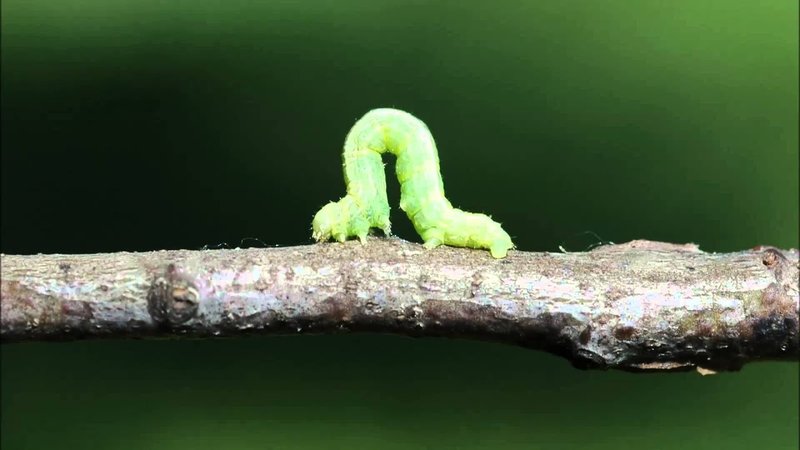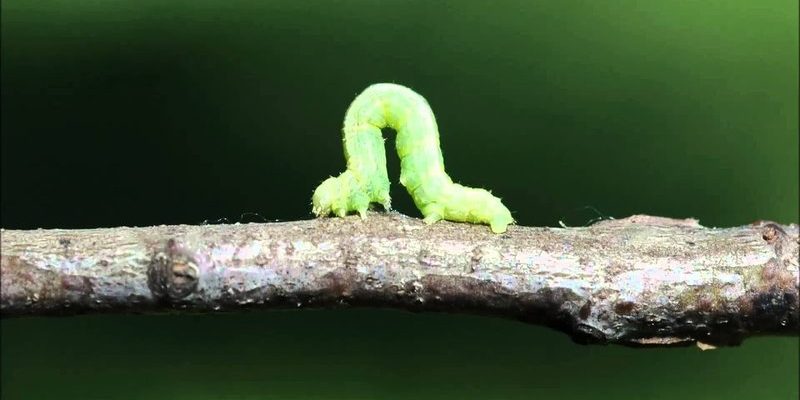
Inchworms are actually the larvae of certain moth species, and their unique movement is not just for show. It’s a clever adaptation that helps them survive in their environments. Imagine you’re trying to sneak past a giant predator—how would you move to stay off their radar? That’s the basic idea behind the inchworm’s wiggly walk. Let’s dive deeper into the world of inchworms and discover what makes them so special.
Understanding Inchworms: What Are They?
Inchworms are not a single species but a term used for the larvae of various moth species, primarily from the family Geometridae. These tiny creatures can measure anywhere from one to two inches long, depending on their species and developmental stage. They come in various colors and patterns, commonly green or brown, which help them blend into their surroundings.
Their coloring is a clever disguise, allowing them to hide from predators. It’s like wearing camouflage in the wild! When inchworms feel threatened, they often curl up to mimic a twig or a leaf, making it even harder to spot them. This stealthy survival tactic is essential, especially when they are vulnerable during their larval stage.
Inchworms are primarily found in gardens and wooded areas where they feast on the leaves of various plants. You might notice them in your backyard or during a hike. They are not harmful and actually play an important role in the ecosystem, serving as a food source for birds and other wildlife.
Why Do Inchworms Move Like That?
So, what’s with the inching movement? Well, inchworms have a unique way of locomotion that’s quite fascinating. Instead of moving like most caterpillars, they use a method called “looping.” This means they create a loop with their bodies, moving forward by grabbing onto something with their prolegs at the rear while their front end reaches ahead.
Here’s how it works: when an inchworm wants to move, it stretches its body forward and anchors its back end. Then it pulls its rear towards the front. This motion creates that characteristic inching action, making them look like they’re measuring their way along each step.
This way of moving is not just for show. It helps inchworms navigate through the foliage and reach their food sources without drawing too much attention. The slow, careful movements keep them under the radar of predators like birds, and it’s part of what makes them so intriguing.
Life Cycle of Inchworms
Inchworms undergo a fascinating transformation as they grow up. They start as tiny eggs laid on leaves and hatch into larvae, which we commonly refer to as inchworms. As they munch on leaves, they grow and eventually reach a pupal stage. Like all good stories, this one has a twist—a metamorphosis!
After a few weeks or months, depending on the species and environmental conditions, they form a cocoon. Inside this protective shell, they undergo a stunning transformation, finally emerging as adult moths. The life cycle of an inchworm is an excellent reminder of nature’s magic, showing us how something so small can change into something completely different.
You might wonder how long it takes for an inchworm to become a moth. Typically, this entire process can take anywhere from a few weeks to several months. Factors like temperature, humidity, and food availability can influence their development. If you’re patient and observant, you might get to witness this incredible journey.
Inchworms in Nature: Their Role and Importance
Inchworms play a crucial role in the ecosystem. As herbivores, they consume plant leaves, which helps keep plant populations in check. This browsing prevents certain species from becoming too dominant, promoting a healthy balance within their habitat.
Moreover, inchworms are an important food source for many birds and other animals. They serve as a nutritious snack, especially in spring when many birds are feeding their young. By contributing to the food web, inchworms help support a variety of wildlife, showcasing the interconnectedness of nature.
It’s also interesting to note that some species of inchworms can indicate the health of an ecosystem. If there’s a noticeable increase or decrease in their population, it might signal changes in the environment, such as pollution levels or climate change. These little guys truly are indicators of the world around us, making them even more worthy of our attention.
How to Spot and Identify Inchworms
If you want to play detective and spot inchworms in your garden or local park, there are a few tips to help you identify them quickly. First, look for their signature movement. Unlike more traditional caterpillars, inchworms move by looping their bodies as we discussed earlier. This makes them fairly easy to spot if you’re aware of how they move.
Next, pay attention to their coloration. Inchworms can be green, brown, or even have stripes or spots, making them blend in with the foliage. Look at the leaves of plants and trees, especially during the spring and summer months when they’re most active.
Lastly, remember that inchworms are generally harmless, so there’s no need to worry about them munching on your plants too much. If you’re keen on getting a closer look, try using a magnifying glass to see the tiny details of their bodies—like their prolegs, which help them grip onto surfaces.
Inchworms and Gardening: Friends or Foes?
Inchworms can be a gardener’s best friend or a troublesome foe. On one hand, they help with natural pest control by acting as food for birds and other predators. On the other hand, they sometimes munch on your prized plants. It’s all about balance!
If you discover inchworms in your garden, don’t panic. First, assess their population. A few inchworms might not do significant harm, but if they seem to be multiplying, you might want to take action. There are several eco-friendly methods you can use to control their numbers without resorting to harmful pesticides.
For instance, introducing natural predators such as birds or even ladybugs can help maintain the population balance in your garden. You might also want to consider hand-picking them off plants. Just wear gloves if you prefer! Remember, the goal is to find a solution that works with nature rather than against it.
Inchworms, with their unique movement and life cycle, are more than just tiny pests; they are fascinating creatures that contribute to the biodiversity of our environments. From their clever way of navigating through leaves to their role in the ecosystem, inchworms remind us of the beauty and complexity of nature.
If you happen to spot one of these inching wonders, take a moment to appreciate the little journey it’s on. Each inch of movement tells a story of survival, transformation, and balance in the natural world. So, the next time you see one, you’ll know exactly what it is and why it moves like that—an inchworm doing its best to go unnoticed in a big, beautiful world!

